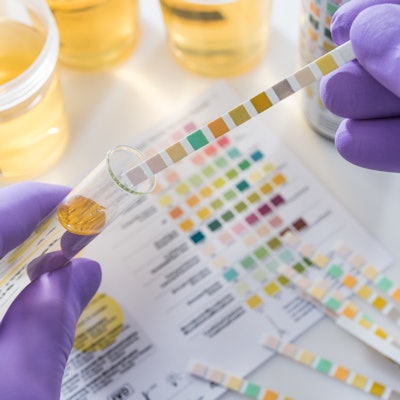
Best practices for urine testing to detect nonmedical opioid use in cancer patients need some rethinking, in light of the intake of other drugs and the risk for diversion of prescribed medicines, according to a single-center study of electronic medical records published online February 6 in JAMA Oncology.
Approaches vary for monitoring cancer patients who are prescribed opioids on a long-term basis. Patients may be selected on a random basis, or, alternatively, screening may be focused on those with a higher likelihood of abuse.
In a study of cancer patients on long-term opioid therapy and being treated at an outpatient clinic, abnormal findings on urine drug tests were reported in more than one in four cases. What's more, excluding marijuana, which has become more acceptable over time as opposed to being viewed as an illicit drug, the rate of nonmedical opioid use "remained considerably high" with positive results in one in six, wrote Dr. Eduardo Bruera, chair of palliative, rehabilitation, and integrative medicine at the University of Texas MD Anderson Cancer Center, and colleagues in a research letter.
Wanted: Best practices
Guidance is currently lacking on the frequency and timing of urine drug testing in cancer patients taking opioid therapy, the authors noted.
The retrospective study compared findings for targeted versus random screening, based on an analysis of electronic medical records. Screening was done with an immunoassay test, and if the results were positive, they were followed up with evaluation on gas chromatography-mass spectrometry (GC-MS).
| Examples of abnormal/unexpected findings in urine tests (n = 119)* | ||
| Random testing (n = 68) | Targeted testing (n = 51) | |
| Unprescribed opioids | Fentanyl, hydrocodone, hydromorphone, morphine, oxycodone | Codeine, hydrocodone, hydromorphone, morphine, oxycodone |
| Illicit drugs | Amphetamine, cocaine, marijuana | Amphetamine, cocaine, marijuana, phencyclidine |
Source: Bruera et al, JAMA Oncology.
The proportion of people with abnormal findings was 43% in the targeted cohort, which included 88 patients, versus 28% for those in the random testing group, which included 212. Suspicious results were more commonly reported in patients who were younger, male, and/or had anxiety.
"Although the frequency of abnormal [urine drug testing] in the random group was significantly lower than in the targeted group, it was still quite high, suggesting that routine random monitoring may be justified among patients with cancer receiving opioids," the authors noted.
They also reported that no prescribed opioids were detected in 19% of the random cohort and 28% of the targeted screening group, which suggests opioid diversion.
"This is particularly concerning because such opioids may end up being used by individuals other than patients and contribute to the risk for unintentional overdose or death," the authors wrote.
"Ultimately, further studies are needed to guide clinical practice regarding the use of [urine drug testing] among patients treated with opioids for cancer pain," they suggested.



















